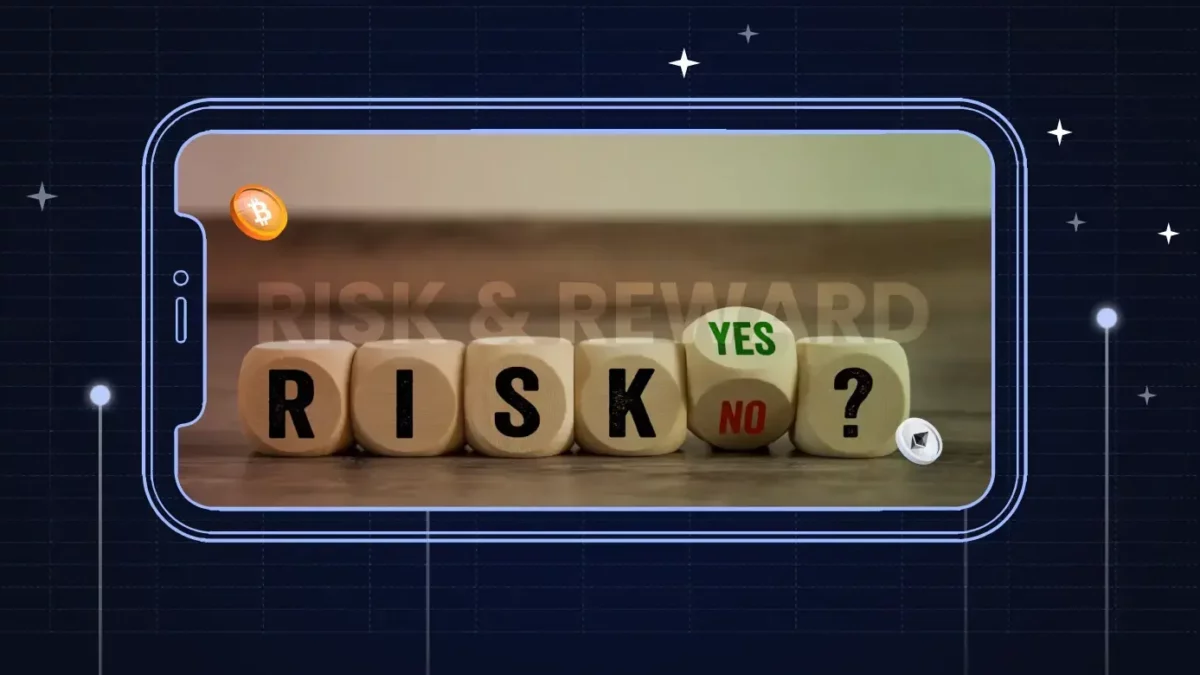Table of Contents
ToggleIntroduction
In the dynamic world of crypto trading, where every move can spark either exhilarating gains or unexpected losses, understanding the risk and reward ratio becomes a vital tool in a trader’s arsenal. Picture this: every trade embarked upon is like a calculated leap into cryptos’ thrilling yet unpredictable realm.
The risk and reward ratio acts as a seasoned guide, offering a structured framework to evaluate the potential of your leaps before taking them. But what exactly is this ratio? How does it influence trading decisions? Let’s delve deeper into the world of risk and reward ratios in crypto trading, exploring its meaning, the formula that shapes it, and how mastering this metric can tilt the scales in your favor amidst the market’s unpredictability. So, fasten your seatbelts as we navigate the fascinating landscape of risk and reward in crypto trading.
So, What is A Risk/Reward Ratio?
Understanding the risk/reward ratio is similar to deciphering the balance between potential gains and losses in a trade. This ratio acts as a compass, guiding traders through the turbulent seas of crypto markets. The formula is simple: it divides the potential profit of a trade by the potential loss. For instance, let’s consider a scenario: a trader plans to buy Ethereum at $3,000 with a stop-loss set at $2,800 and a take-profit at $3,400. Here’s how the risk/reward ratio pans out:
Potential Profit: $3,400 – $3,000 = $400 Potential Loss: $3,000 – $2,800 = $200
So, the risk/reward ratio for this trade would be calculated as:
Risk/Reward Ratio = Potential Profit / Potential Loss
Risk/Reward Ratio = $400 / $200 = 2
In this example, the risk/reward ratio stands at 2, indicating that for every dollar put at risk, there’s a potential to gain $2. A ratio higher than one implies that the potential reward outweighs the risk, theoretically favoring the trade.
Such calculations empower traders to make informed decisions. By evaluating risk and reward before executing a trade, they gain a clearer perspective on the potential outcome, aiding in better risk management and strategic trade placements in the ever-changing crypto market.
Learn More: Top Crypto Day Trading Strategy
Factors To Consider While Determining Risk/Reward Ratio
- Volatility and Market Conditions:
- Explanation: Volatile markets tend to exhibit more substantial price swings, affecting risk/reward ratios. Understanding the current market volatility is crucial as it directly influences potential profits and losses.
- Relevance: Higher volatility might lead to wider stop-loss or take-profit placements, significantly impacting the risk/reward ratio calculation.
- Entry and Exit Points:
- Explanation: Deciding entry and exit points is pivotal in risk/reward assessment. Closer entry points to the stop-loss imply lower risk, but may potentially limit profits, affecting the ratio.
- Relevance: Identifying strategic entry and exit positions is crucial to optimize risk/reward ratios and ensure favorable trade outcomes.
- Position Sizing and Risk Tolerance:
- Explanation: The amount invested in a trade (position sizing) directly influences risk/reward. Smaller positions may reduce risk but could limit potential profits.
- Relevance: Assessing personal risk tolerance aids in determining suitable risk/reward ratios, aligning with individual trading goals and strategies.
- Market Analysis and Timing:
- Explanation: Thorough market analysis helps anticipate potential price movements, which is essential for setting risk/reward ratios. Timing entry and exit points based on this analysis is critical.
- Relevance: Proper timing and analysis enhance the accuracy of risk/reward ratios, offering better insights into potential outcomes.
- Risk Management Strategies:
- Explanation: Implementing risk management techniques like trailing stop-loss orders or profit-taking strategies can dynamically impact risk/reward ratios.
- Relevance: Integrating effective risk management tactics can adjust risk/reward ratios, ensuring better trade outcomes and preserving capital.
- Historical Data and Backtesting:
- Explanation: Analyzing past trades (backtesting) aids in understanding how different risk/reward ratios performed in similar market conditions.
- Relevance: Utilizing historical data refines understanding risk/reward ratios, facilitating better decision-making in future trades.
These considerations form the foundation for traders to gauge and determine effective risk/reward ratios, providing a clearer path in navigating the complexities of crypto trading.
Additional Read: When is the Best Time to Trade in Crypto Market?
How Do You Calculate A Risk/Reward Ratio?
Suppose you’re considering a trade on Bitcoin (BTC) with the following parameters:
- Entry Point: $50,000
- Stop-Loss Level: $48,000
- Target Price: $56,000
Calculation:
- Determine Risk:
- Risk Amount = Entry Point – Stop-Loss Level
- Risk = $50,000 – $48,000 = $2,000
- Determine Reward:
- Reward Amount = Target Price – Entry Point
- Reward = $56,000 – $50,000 = $6,000
- Calculate Risk/Reward Ratio:
- Risk/Reward Ratio = Risk / Reward
- Ratio = $2,000 / $6,000 = 1:3
Interpretation:
This risk/reward ratio of 1:3 implies that for every $1 at risk in this trade, the potential reward is $3. It suggests that, statistically, you aim to gain three times the amount you’re risking in this trade.
Importance of the Ratio:
- A 1:3 risk/reward ratio signifies a more favorable trade setup.
- Higher ratios (like 1:3) often indicate potentially more profitable trades with a risk-averse approach.
- Evaluating multiple trade opportunities with different risk/reward ratios aids in selecting trades offering better potential returns relative to the risk.
Calculating and interpreting risk/reward ratios is pivotal in crypto trading. It helps traders make informed decisions by weighing potential risks against rewards for each trade opportunity.
Read On: How to Start Trading Crypto Under $100?
Why is the Risk/Reward Ratio so Important in Crypto Trading?
Some of the most important reasons why a risk-to-reward ratio is crucial to know before entering a trade in the crypto market, or any market for that matter, are as follows:
- Effective Risk Management:
- Minimizing Losses: A well-calculated risk/reward ratio enables traders to set appropriate stop-loss levels, minimizing potential losses in volatile crypto markets.
- Capital Preservation: It helps preserve trading capital by limiting the amount of capital at risk per trade relative to potential gains.
- Strategic Trade Selection:
- Trade Prioritization: Evaluating risk/reward ratios aids in prioritizing trades with favorable ratios and selecting opportunities that offer higher potential returns for the risk undertaken.
- Weeding Out Poor Opportunities: It assists in filtering out trades with poor risk/reward profiles, helping traders focus on setups with better profit potential.
- Psychological Impact:
- Reduced Emotional Trading: A calculated risk/reward ratio provides a clear framework, reducing impulsive and emotionally driven trades.
- Enhanced Discipline: It instills discipline by encouraging traders to adhere to predetermined risk levels and trade setups, reducing the impact of emotional decisions.
- Performance Evaluation:
- Trade Analysis: It allows traders to assess the effectiveness of their trading strategies by analyzing the success rate of trades with varying risk/reward ratios.
- Improving Strategies: By tracking and evaluating the ratio over multiple trades, traders can refine their strategies for better risk-adjusted returns.
- Maximizing Profit Potential:
- Optimal Risk Distribution: A balanced risk/reward ratio ensures that the potential reward justifies the assumed risk, aiming for higher profitability while managing downside risk.
- Long-Term Consistency: Consistently aiming for favorable risk/reward ratios contributes to long-term trading success by aligning trading decisions with profitable outcomes.
Understanding and implementing an effective risk/reward ratio is fundamental for crypto traders, aiding in making informed decisions, managing risk exposure, and optimizing profitability in an inherently volatile market.
What is a Good Risk-to-Reward Ratio?
Determining what constitutes a “good” risk-to-reward ratio in crypto trading isn’t a one-size-fits-all scenario. It’s a dynamic metric influenced by several variables, including:
- Trader’s Risk Appetite:
- Varied Preferences: Some traders may seek a higher risk-to-reward ratio, aiming for larger profits despite accepting higher potential losses.
- Conservative Approach: Others may prefer a more conservative ratio, prioritizing risk management by accepting smaller gains with limited risk exposure.
- Nature of the Asset and Market Conditions:
- Volatility Levels: Highly volatile assets may necessitate adjusting the risk-to-reward ratio to accommodate the market’s unpredictability.
- Market Trends: During strong bullish trends, traders might opt for a lower ratio due to higher probabilities of successful trades.
- Trading Strategy and Objectives:
- Scalping vs. Long-Term Trading: Short-term traders (scalpers) may seek higher ratios for quick profits, while long-term investors might aim for lower ratios for more significant gains.
- Specific Strategies: Certain strategies, such as breakout or momentum trading, might require different risk-to-reward ratios to align with their characteristics.
- Overall Market Conditions:
- Market Sentiment: In bullish markets, traders might target higher ratios, whereas in bearish or uncertain markets, a more conservative approach could be preferred.
- External Factors: Economic events, regulatory changes, or technological developments can influence traders’ risk tolerance and, consequently, their preferred risk-to-reward ratio.
- Adaptability and Flexibility:
- Adjusting Strategies: Traders might alter their risk-to-reward ratios based on changing market dynamics or personal circumstances.
- Continuous Evaluation: Regularly assess and adjust ratios to align with current market conditions and personal risk tolerance levels.
Ultimately, what constitutes a good risk-to-reward ratio varies from trader to trader and can evolve over time. It’s a dynamic aspect of trading that requires adaptation, strategy alignment, and an understanding of one’s risk tolerance and market conditions. Therefore, defining a “good” ratio hinges on a trader’s preferences, asset type, market conditions, and implementation strategy.
Know More: Top Indicator for Crypto Trading?
Conclusion
Understanding and effectively employing the risk-to-reward ratio in crypto trading is pivotal for optimizing strategies and managing potential losses. This fundamental metric, encompassing risk management and profit expectations, guides traders through the turbulent waters of market volatility.
By integrating calculated risk assessment and strategic decision-making, traders can harness the potential of risk-to-reward ratios to make informed trade choices. This approach enables them to navigate the complex crypto market landscape while balancing risk and reward.
Remember, the quest for a favorable risk-to-reward ratio isn’t about finding a universal benchmark but crafting a personalized approach that resonates with individual trading goals and market circumstances. It’s a journey of adaptation, fluidity, and continuous refinement to leverage this crucial metric effectively in the ever-evolving crypto trading realm.
Related posts
Understanding the Different Types of Cryptos: Coins, Tokens, Altcoins & More Explained
Explore the major types of crypto assets and their unique roles.
Read more
PAWS Telegram Game: The New Tap to Earn Game That Is Beating Hamster Kombat
Discover how to play and earn with PAWS Telegram game.
Read more


